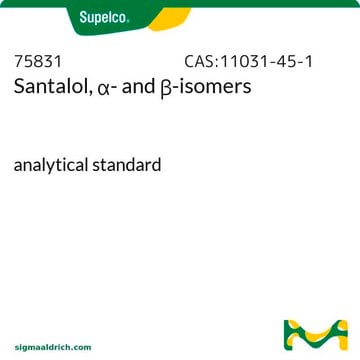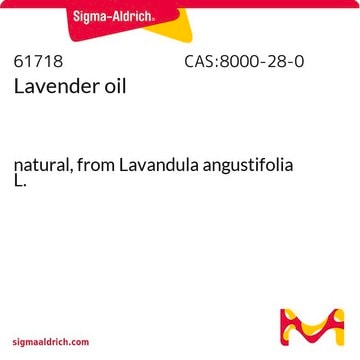All Photos(1)
About This Item
Organoleptic:
woody; spicy; herbaceous; balsamic
grade:
Halal
Kosher
natural
Kosher
natural
biological source:
Santalum album l.
food allergen:
no known allergens
Recommended Products
biological source
Santalum album l.
Quality Level
grade
Halal
Kosher
natural
optical activity
[α]20/D −15°, neat
refractive index
n20/D 1.507 (lit.)
bp
276 °C (lit.)
density
0.974 g/mL at 25 °C (lit.)
application(s)
flavors and fragrances
Documentation
see Safety & Documentation for available documents
food allergen
no known allergens
Organoleptic
woody; spicy; herbaceous; balsamic
Looking for similar products? Visit Product Comparison Guide
Preparation Note
Extraction method: steam distillation
Disclaimer
For R&D or non-EU Food use. Not for retail sale.
Signal Word
Warning
Hazard Statements
Precautionary Statements
Hazard Classifications
Eye Irrit. 2 - Skin Irrit. 2 - Skin Sens. 1 - STOT SE 3
Target Organs
Respiratory system
Storage Class Code
10 - Combustible liquids
WGK
WGK 2
Flash Point(F)
Not applicable
Flash Point(C)
Not applicable
Personal Protective Equipment
dust mask type N95 (US), Eyeshields, Gloves
Choose from one of the most recent versions:
Already Own This Product?
Find documentation for the products that you have recently purchased in the Document Library.
Manickam Paulpandi et al.
Phytomedicine : international journal of phytotherapy and phytopharmacology, 19(3-4), 231-235 (2011-12-24)
The anti-influenza A/HK (H3N2) virus activity of β-santalol was evaluated in MDCK cells and investigated the effect of β-santalol on synthesis of viral mRNAs. β-Santalol was investigated for its antiviral activity against influenza A/HK (H3N2) virus using a cytopathic effect
Manjinder Kaur et al.
Carcinogenesis, 26(2), 369-380 (2004-11-06)
alpha-Santalol, an active component of sandalwood oil, has been studied in detail in recent years for its skin cancer preventive efficacy in murine models of skin carcinogenesis; however, the mechanism of its efficacy is not defined. Two major biological events
Guipu Li et al.
Lipids, 48(2), 105-113 (2013-01-01)
The aim of the present study was to investigate the effect of sandalwood seed oil on fatty acid (FA) profiles and inflammatory factors in rats. Fifty male Sprague-Dawley rats were randomly divided into five different dietary groups: 10 % soybean
George A Burdock et al.
Food and chemical toxicology : an international journal published for the British Industrial Biological Research Association, 46(2), 421-432 (2007-11-06)
Sandalwood (Santalum album L.) is a fragrant wood from which oil is derived for use in food and cosmetics. Sandalwood oil is used in the food industry as a flavor ingredient with a daily consumption of 0.0074 mg/kg. Over 100
Repellent effect of santalol from sandalwood oil against Tetranychus urticae (Acari: Tetranychidae).
Hyun Sik Roh et al.
Journal of economic entomology, 105(2), 379-385 (2012-05-23)
Thirty-four essential oils were screened for their repellent activities against the twospotted spider mite, Tetranychus urticae Koch (Acarina: Tetranychidae), at 0.1% concentration level using choice and no-choice laboratory bioassays. Of these, 20 essential oils showed significant repellencies against T. urticae
Our team of scientists has experience in all areas of research including Life Science, Material Science, Chemical Synthesis, Chromatography, Analytical and many others.
Contact Technical Service






